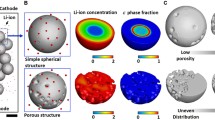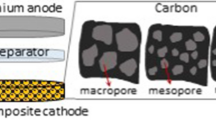Abstract
Herein, we present a new model to investigate the cause of the low initial coulombic efficiency of lithium-ion battery (LIB) porous carbon anodes and discover its relationship with the porosity of these materials. According to the proposed model, the capacity of porous carbon LIB anodes is in a direct relationship with their porosity, which reduces by the formation of the solid electrolyte interphase (SEI) layer occupying the cavities and decreasing the accessible surface area for the electrolyte. The introduced model in this study was compared with the data published in the literature and revealed a satisfactory agreement with them. As a result, it was concluded that the fraction of the mesopores occupied by SEI after the 1st cycle fluctuates around the value of 0.5 and is mostly in the range of 0.6−0.4. Thereby, it can be employed for the prediction of the first cycle coulombic efficiency (CE) of carbonaceous anodes as LIB anodes and optimization of their structure.
Graphical Abstract





Similar content being viewed by others
Data Availability
All data and materials involved in this research are available in the manuscript.
References
Fathi, A.R., Riahifar, R., Raissi, B., Sahba Yaghmaee, M., Ghorbanzadeh, M.: Optimization of cathode material components by means of experimental design for li-ion batteries. J. Electron. Mater. 49(11), 6547–6558 (2020)
Sabetzadeh, N., Falamaki, C., Riahifar, R., Yaghmaee, M.S., Raissi, B.: Plasma treatment of polypropylene membranes coated with zeolite/organic binder layers: Assessment of separator performance in lithium-ion batteries. Solid State Ionics. 363, 115589 (2021)
Shaker, M., Ghazvini, A.A.S., Cao, W., Riahifar, R., Ge, Q.: Biomass-derived porous carbons as supercapacitor electrodes—a review. New Carbon Mater. 36(3), 546–572 (2021)
Shaker, M., Riahifar, R., Li, Y.: A review on the superb contribution of carbon and graphene quantum dots to electrochemical capacitors’ performance: synthesis and application. FlatChem 22, 100171 (2020)
Asl, V.Z., Chini, S.F., Zhao, J., Palizdar, Y., Shaker, M., Sadeghi, A.: Corrosion properties and surface free energy of the Zn-Al LDH/rGO coating on MAO pretreated AZ31 magnesium alloy. Surface Coat. Technol. p. 127764. (2021)
Leng, X., Chen, S., Yang, K., Chen, M., Shaker, M., Vdovin, E.E., Ge, Q., Novoselov, K.S., Andreeva, D.V.: Introduction to two-dimensional materials. Molecular interactions on two-dimensional materials, World Scientific. p. 1-41 (2022)
Shaker, M., Salahinejad, E., Cao, W., Meng, X., Zahedi Asl, V., Ge, Q.: The effect of graphene orientation on permeability and corrosion initiation under composite coatings. Constr. Build. Mater. 319, 126080 (2022)
Deng, X., Li, S., Wang, J., Nan, D., Dong, J., Liu, J.: Nitrogen-doped zinc/cobalt mixed oxide micro-/nanospheres for high-rate lithium-ion battery anode. J. Mater. Res. 34(18), 3204–3211 (2019)
Cao, X., Chen, S., Wang, G.: Porous carbon particles derived from natural peanut shells as lithium ion battery anode and its electrochemical properties. Electron. Mater. Lett. 10(4), 819–826 (2014)
Leng, X., Chen, S., Yang, K., Chen, M., Shaker, M., Vdovin, E.E., Ge, Q., Novoselov, K.S., Andreeva, D.V.: Technology and applications of graphene oxide membranes, in Molecular Interactions On Two-dimensional Materials. World Scientific. p. 379–422. (2022)
Paronyan, T.M.: Weakened interlayer interaction of incommensurate graphene as a key factor for superior lithium intercalation. J. Mater. Res. 36(14), 2872–2880 (2021)
Xu, Z., Chen, J., Wu, M., Chen, C., Song, Y., Wang, Y.: Effects of different atmosphere on electrochemical performance of hard carbon electrode in sodium ion battery. Electron. Mater. Lett. 15(4), 428–436 (2019)
Zhang, Y., Li, X., Wang, Q., Miao, J., Tian, H., Liu, X., Shen, N., Li, X.: A wax gourd flesh-derived porous carbon activated by different activating agents as lithium ion battery anode material. J. Mater. Sci. Mater. Electron. 32(19), 23776–23785 (2021)
Yu, K., Wang, B., Bai, P., Liang, C., Jin, W.: Wheat straw cellulose amorphous porous carbon used as anode material for a lithium-ion battery. J. Electron. Mater. 50(11), 6438–6447 (2021)
Zhang, Q., Li, M., Meng, Y., Li, A.: KOH Activated nitrogen doped hard carbon nanotubes as high performance anode for lithium ion batteries. Electron. Mater. Lett. 14(6), 755–765 (2018)
Yang, X., Li, C., Zhang, G., Yang, C.: Polystyrene-derived carbon with hierarchical macro–meso–microporous structure for high-rate lithium-ion batteries application. J. Mater. Sci. 50(20), 6649–6655 (2015)
Guo, W., Li, X., Xu, J., Liu, H.K., Ma, J., Dou, S.X.: Growth of highly nitrogen-doped amorphous carbon for lithium-ion battery anode. Electrochim. Acta 188, 414–420 (2016)
Shaker, M., Sadeghi Ghazvini, A.A., Feng, S., Cao, W., Meng, X., Ge, Q., Riahifar, R.: Improving the Electrochemical Performance of Pouch Cell Electric Double-Layer Capacitors by Integrating Graphene Nanoplates into Activated Carbon. Energy Technology. n/a(n/a): p. 2100735
Peng, Y.-T., Lo, C.-T.: Effect of microstructure and morphology of electrospun ultra-small carbon nanofibers on anode performances for lithium ion batteries. J. Electrochem. Soc. 162(6), A1085–A1093 (2015)
Sadeghi Ghazvini, A.A., Taheri-Nassaj, E., Raissi, B., Riahifar, R., Sahba Yaghmaee, M., Shaker, M.: Co-electrophoretic deposition of Co3O4 and graphene nanoplates for supercapacitor electrode. Mater. Lett. 285, 129195 (2021)
Shaker, M., Ghazvini, A.A.S., Yaghmaee, M.S., Riahifar, R., Raissi, B., Cao, W., Ge, Q., Wang, B.: Prediction of size-and shape-dependent lithium storage capacity of carbon nano-spheres (quantum dots). J. Nanopart. Res. 23(8), 1–9 (2021)
Chen, L., Zhang, Y., Lin, C., Yang, W., Meng, Y., Guo, Y., Li, M., Xiao, D.: Hierarchically porous nitrogen-rich carbon derived from wheat straw as an ultra-high-rate anode for lithium ion batteries. J. Mater. Chem. A. 2(25), 9684–9690 (2014)
Jiang, H., Lee, P.S., Li, C.: 3D carbon based nanostructures for advanced supercapacitors. Energy Environ. Sci. 6(1), 41–53 (2013)
Patil, A., Patil, V., Wook Shin, D., Choi, J.-W., Paik, D.-S., Yoon, S.-J.: Issue and challenges facing rechargeable thin film lithium batteries. Mater. Res. Bull. 43(8), 1913–1942 (2008)
Zhou, H., Zhu, S., Hibino, M., Honma, I., Ichihara, M.: Lithium storage in ordered mesoporous carbon (CMK-3) with high reversible specific energy capacity and good cycling performance. Adv. Mater. 15(24), 2107–2111 (2003)
Fang, B., Kim, M.-S., Kim, J.H., Lim, S., Yu, J.-S.: Ordered multimodal porous carbon with hierarchical nanostructure for high Li storage capacity and good cycling performance. J. Mater. Chem. 20(45), 10253–10259 (2010)
Shaker, M., Ghazvini, A.A.S., Qureshi, F.R., Riahifar, R.: A criterion combined of bulk and surface lithium storage to predict the capacity of porous carbon lithium-ion battery anodes: lithium-ion battery anode capacity prediction. Carbon Lett. (2021)
Yang, J., Zhou, X., Li, J., Zou, Y., Tang, J.: Study of nano-porous hard carbons as anode materials for lithium ion batteries. Mater. Chem. Phys. 135(2–3), 445–450 (2012)
Yang, X., Wei, C., Sun, C., Li, X., Chen, Y.: High performance anode of lithium-ion batteries derived from an advanced carbonaceous porous network. J. Alloys Compd. 693, 777–781 (2017)
Song, R., Song, H., Zhou, J., Chen, X., Wu, B., Yang, H.Y.: Hierarchical porous carbon nanosheets and their favorable high-rate performance in lithium ion batteries. J. Mater. Chem. 22(24), 12369–12374 (2012)
Wang, Z., Zhang, F., Lu, Y., Zhai, B., Zhai, S., Xiao, Z., An, Q., Yu, C., Gao, S.: Facile synthesis of three-dimensional porous carbon sheets from a water-soluble biomass source sodium alginate for lithium ion batteries. Mater. Res. Bull. 83, 590–596 (2016)
Yang, X., Li, X., Li, Z., Zhang, G., Wu, D.: Mesoporous wormholelike carbon with controllable nanostructure for lithium ion batteries application. Mater. Res. Bull. 66, 83–87 (2015)
Guo, D.C., Han, F., Lu, A.H.: Porous Carbon anodes for a high capacity lithium-ion battery obtained by incorporating silica into benzoxazine during polymerization. Chem. Eur. J. 21(4), 1520–1525 (2015)
Ou, J., Zhang, Y., Chen, L., Guo, Y., Xiao, D.: Hierarchical porous carbons fabricated from silica via flame synthesis as anode materials for high-performance lithium-ion batteries. Ionics. 21(7), 1881–1891 (2015)
Chen, Y., Shi, L., Li, A., Zhang, S., Guo, M., Chen, X., Zhou, J., Song, H.: Capacity enhancement of porous carbon electrodes during long-term cycling in lithium-ion batteries. J. Electrochem. Soc. 164(9), A2000 (2017)
Acknowledgements
The authors are thankful to Professor Hans-Peter Steinrück for his useful comments.
Author information
Authors and Affiliations
Corresponding author
Ethics declarations
Conflict of interest
The authors declare that they do have no conflicts of interest to declare.
Additional information
Publisher’s Note
Springer Nature remains neutral with regard to jurisdictional claims in published maps and institutional affiliations.
Rights and permissions
About this article
Cite this article
Shaker, M., Sadeghi Ghazvini, A., Riahifar, R. et al. On the Relationship Between the Porosity and Initial Coulombic Efficiency of Porous Carbon Materials for the Anode in Lithium-Ion Batteries. Electron. Mater. Lett. 18, 400–406 (2022). https://doi.org/10.1007/s13391-022-00354-8
Received:
Accepted:
Published:
Issue Date:
DOI: https://doi.org/10.1007/s13391-022-00354-8




